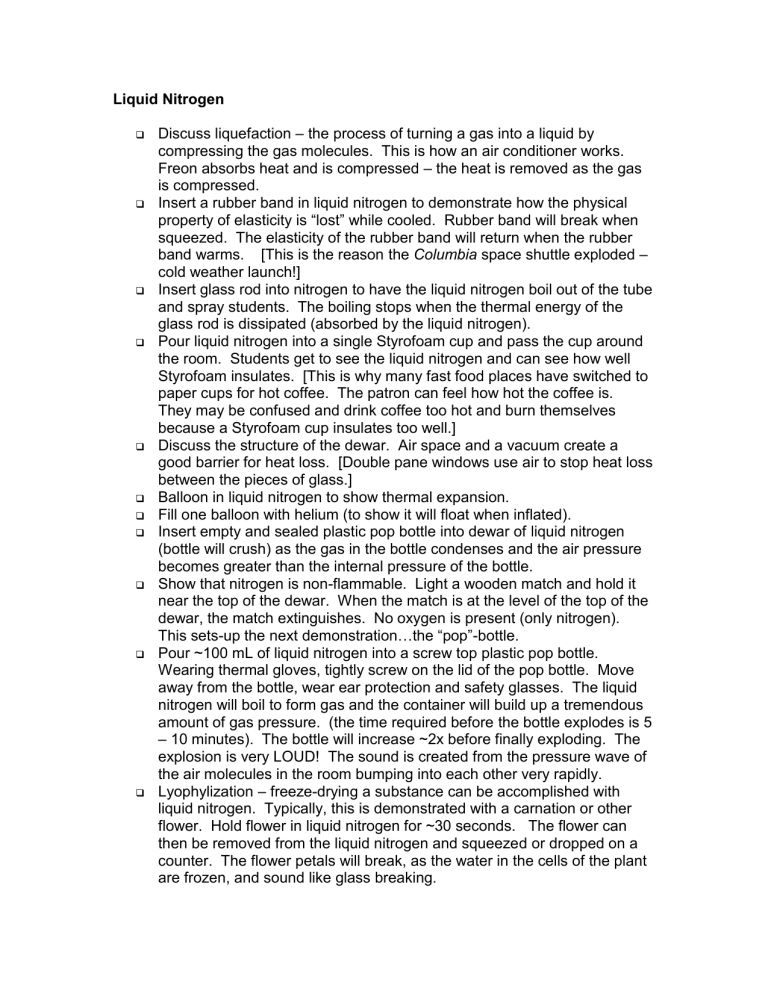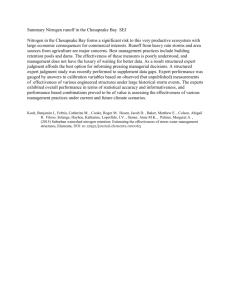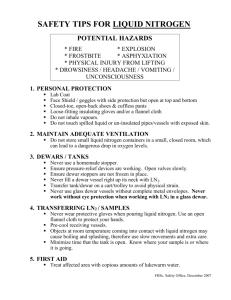Liquid Nitrogen

Liquid Nitrogen
Discuss liquefaction – the process of turning a gas into a liquid by compressing the gas molecules. This is how an air conditioner works.
Freon absorbs heat and is compressed – the heat is removed as the gas is compressed.
Insert a rubber band in liquid nitrogen to demonstrate how the physical property of elasticity is “lost” while cooled. Rubber band will break when squeezed. The elasticity of the rubber band will return when the rubber band warms. [This is the reason the Columbia space shuttle exploded
– cold weather launch!]
Insert glass rod into nitrogen to have the liquid nitrogen boil out of the tube and spray students. The boiling stops when the thermal energy of the glass rod is dissipated (absorbed by the liquid nitrogen).
Pour liquid nitrogen into a single Styrofoam cup and pass the cup around the room. Students get to see the liquid nitrogen and can see how well
Styrofoam insulates. [This is why many fast food places have switched to paper cups for hot coffee. The patron can feel how hot the coffee is.
They may be confused and drink coffee too hot and burn themselves because a Styrofoam cup insulates too well.]
Discuss the structure of the dewar. Air space and a vacuum create a good barrier for heat loss. [Double pane windows use air to stop heat loss between the pieces of glass.]
Balloon in liquid nitrogen to show thermal expansion.
Fill one balloon with helium (to show it will float when inflated).
Insert empty and sealed plastic pop bottle into dewar of liquid nitrogen
(bottle will crush) as the gas in the bottle condenses and the air pressure becomes greater than the internal pressure of the bottle.
Show that nitrogen is non-flammable. Light a wooden match and hold it near the top of the dewar. When the match is at the level of the top of the dewar, the match extinguishes. No oxygen is present (only nitrogen).
This setsup the next demonstration…the “pop”-bottle.
Pour ~100 mL of liquid nitrogen into a screw top plastic pop bottle.
Wearing thermal gloves, tightly screw on the lid of the pop bottle. Move away from the bottle, wear ear protection and safety glasses. The liquid nitrogen will boil to form gas and the container will build up a tremendous amount of gas pressure. (the time required before the bottle explodes is 5
– 10 minutes). The bottle will increase ~2x before finally exploding. The explosion is very LOUD! The sound is created from the pressure wave of the air molecules in the room bumping into each other very rapidly.
Lyophylization
– freeze-drying a substance can be accomplished with liquid nitrogen. Typically, this is demonstrated with a carnation or other flower. Hold flower in liquid nitrogen for ~30 seconds. The flower can then be removed from the liquid nitrogen and squeezed or dropped on a counter. The flower petals will break, as the water in the cells of the plant are frozen, and sound like glass breaking.
Cryogenics
– fast freezing for long term storage. Examples: artificial insemination (sperm and eggs frozen) – test-tube babies.
Discuss ethics of research on zygotes! Parents divorce, mother uses zygote and father (sperm donor) is responsible for child-support.








